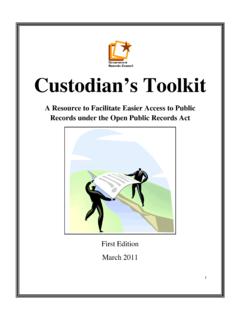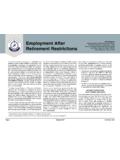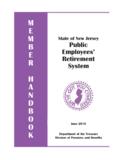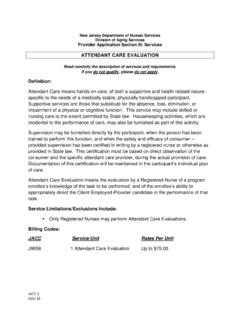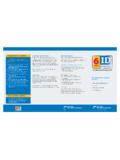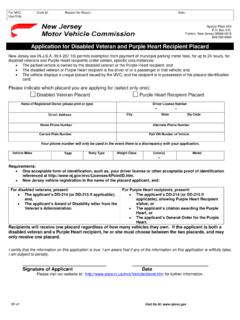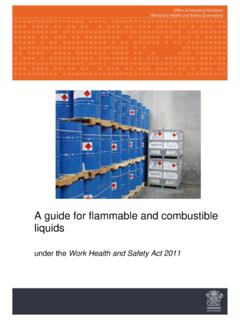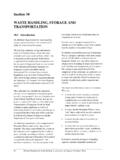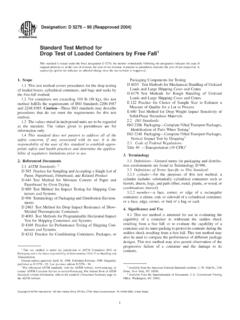Transcription of ETHYL ACETATE HAZARD SUMMARY WORKPLACE EXPOSURE …
1 Common Name: ETHYL ACETATE CAS Number: 141-78-6 DOT Number: UN 1173 ---------------------------------------- --------------------------------- HAZARD SUMMARY * ETHYL ACETATE can affect you when breathed in and by passing through your skin. * ETHYL ACETATE can irritate the skin, eyes, nose and throat. * EXPOSURE to high levels can cause you to feel dizzy, lightheaded, and to pass out. * Repeated contact can cause drying and cracking of the skin. * Long-term EXPOSURE can affect the liver and kidneys. * ETHYL ACETATE is a FLAMMABLE LIQUID and a FIRE HAZARD . IDENTIFICATION ETHYL ACETATE is a colorless liquid with a fragrant, fruity odor. It is used as a solvent, a synthetic flavoring substance, and in making perfumes and dyes. REASON FOR CITATION * ETHYL ACETATE is on the Hazardous Substance List because it is regulated by OSHA and cited by ACGIH, DOT, NIOSH, HHAG, NFPA and EPA. * This chemical is on the Special Health HAZARD Substance List because it is FLAMMABLE.
2 * Definitions are provided on page 5. HOW TO DETERMINE IF YOU ARE BEING EXPOSED The New Jersey Right to Know Act requires most employers to label chemicals in the WORKPLACE and requires public employers to provide their employees with information and training concerning chemical hazards and controls. The federal OSHA HAZARD Communication Standard, , requires private employers to provide similar training and information to their employees. * EXPOSURE to hazardous substances should be routinely evaluated. This may include collecting personal and area air samples. You can obtain copies of sampling results from your employer. You have a legal right to this information under OSHA * If you think you are experiencing any work-related health problems, see a doctor trained to recognize occupational diseases. Take this Fact Sheet with you. RTK Substance number: 0841 Date: June 1996 Revision: July 2002 ---------------------------------------- --------------------------------- WORKPLACE EXPOSURE LIMITS OSHA: The legal airborne permissible EXPOSURE limit (PEL) is 400 ppm averaged over an 8-hour workshift.
3 NIOSH: The recommended airborne EXPOSURE limit is 400 ppm averaged over a 10-hour workshift. ACGIH: The recommended airborne EXPOSURE limit is 400 ppm averaged over an 8-hour workshift. * The above EXPOSURE limits are for air levels only. When skin contact also occurs, you may be overexposed, even though air levels are less than the limits listed above. WAYS OF REDUCING EXPOSURE * Where possible, enclose operations and use local exhaust ventilation at the site of chemical release. If local exhaust ventilation or enclosure is not used, respirators should be worn. * Wear protective work clothing. * Wash thoroughly immediately after EXPOSURE to ETHYL ACETATE and at the end of the workshift. * Post HAZARD and warning information in the work area. In addition, as part of an ongoing education and training effort, communicate all information on the health and safety hazards of ETHYL ACETATE to potentially exposed workers.
4 ETHYL ACETATE page 2 of 6 This Fact Sheet is a SUMMARY source of information of all potential and most severe health hazards that may result from EXPOSURE . Duration of EXPOSURE , concentration of the substance and other factors will affect your susceptibility to any of the potential effects described below. ---------------------------------------- ----------------------------------- HEALTH HAZARD INFORMATION Acute Health Effects The following acute (short-term) health effects may occur immediately or shortly after EXPOSURE to ETHYL ACETATE : * ETHYL ACETATE can irritate the skin, eyes, nose and throat. * EXPOSURE to high levels can cause you to feel dizzy, lightheaded, and to pass out. Chronic Health Effects The following chronic (long-term) health effects can occur at some time after EXPOSURE to ETHYL ACETATE and can last for months or years: Cancer HAZARD * There is no evidence that ETHYL ACETATE causes cancer in animals.
5 This is based on test results presently available to the New Jersey Department of Health and Senior Services from published studies. Reproductive HAZARD * ETHYL ACETATE may decrease fertility in males. other Long-Term Effects * Repeated contact can cause drying and cracking of the skin. * Long-term EXPOSURE can affect the liver and kidneys. MEDICAL Medical Testing Before beginning employment and at regular times after that, for those with frequent or potentially high exposures, the following are recommended: * Liver and kidney function tests. Any evaluation should include a careful history of past and present symptoms with an exam. Medical tests that look for damage already done are not a substitute for controlling EXPOSURE . Request copies of your medical testing. You have a legal right to this information under OSHA Mixed Exposures * Because more than light alcohol consumption can cause liver damage, drinking alcohol may increase the liver damage caused by ETHYL ACETATE .
6 WORKPLACE CONTROLS AND PRACTICES Unless a less toxic chemical can be substituted for a hazardous substance, ENGINEERING CONTROLS are the most effective way of reducing EXPOSURE . The best protection is to enclose operations and/or provide local exhaust ventilation at the site of chemical release. Isolating operations can also reduce EXPOSURE . Using respirators or protective equipment is less effective than the controls mentioned above, but is sometimes necessary. In evaluating the controls present in your WORKPLACE , consider: (1) how hazardous the substance is, (2) how much of the substance is released into the WORKPLACE and (3) whether harmful skin or eye contact could occur. Special controls should be in place for highly toxic chemicals or when significant skin, eye, or breathing exposures are possible. In addition, the following controls are recommended: * Where possible, automatically pump liquid ETHYL ACETATE from drums or other storage containers to process containers.
7 * Before entering a confined space where ETHYL ACETATE may be present, check to make sure that an explosive concentration does not exist. Good WORK PRACTICES can help to reduce hazardous exposures. The following work practices are recommended: * Workers whose clothing has been contaminated by ETHYL ACETATE should change into clean clothing promptly. * Contaminated work clothes should be laundered by individuals who have been informed of the hazards of EXPOSURE to ETHYL ACETATE . * Eye wash fountains should be provided in the immediate work area for emergency use. * If there is the possibility of skin EXPOSURE , emergency shower facilities should be provided. * On skin contact with ETHYL ACETATE , immediately wash or shower to remove the chemical. At the end of the workshift, wash any areas of the body that may have contacted ETHYL ACETATE , whether or not known skin contact has occurred.
8 * Do not eat, smoke, or drink where ETHYL ACETATE is handled, processed, or stored, since the chemical can be swallowed. Wash hands carefully before eating, drinking, smoking, or using the toilet. PERSONAL PROTECTIVE EQUIPMENT WORKPLACE CONTROLS ARE BETTER THAN PERSONAL PROTECTIVE EQUIPMENT. However, for some jobs (such as outside work, confined space entry, jobs done only once in a while, or jobs done while WORKPLACE controls are being installed), personal protective equipment may be appropriate. ETHYL ACETATE page 3 of 6 OSHA requires employers to determine the appropriate personal protective equipment for each HAZARD and to train employees on how and when to use protective equipment. The following recommendations are only guidelines and may not apply to every situation. Clothing * Avoid skin contact with ETHYL ACETATE .
9 Wear solvent-resistant gloves and clothing. Safety equipment suppliers/ manufacturers can provide recommendations on the most protective glove/clothing material for your operation. * All protective clothing (suits, gloves, footwear, headgear) should be clean, available each day, and put on before work. * ACGIH recommends Butyl Rubber as a protective material. Eye Protection * Wear indirect-vent, impact and splash resistant goggles when working with liquids. * Wear a face shield along with goggles when working with corrosive, highly irritating or toxic substances. * Contact lenses should not be worn when working with this substance. Respiratory Protection IMPROPER USE OF RESPIRATORS IS DANGEROUS. Such equipment should only be used if the employer has a written program that takes into account WORKPLACE conditions, requirements for worker training, respirator fit testing and medical exams, as described in OSHA * Where the potential exists for EXPOSURE over 400 ppm, use a MSHA/NIOSH approved full facepiece respirator with an organic vapor cartridge.
10 Increased protection is obtained from full facepiece powered-air purifying respirators. * If while wearing a filter or cartridge respirator you can smell, taste, or otherwise detect ETHYL ACETATE , or if while wearing particulate filters abnormal resistance to breathing is experienced, or eye irritation occurs while wearing a full facepiece respirator, leave the area immediately. Check to make sure the respirator-to-face seal is still good. If it is, replace the filter or cartridge. If the seal is no longer good, you may need a new respirator. * Be sure to consider all potential exposures in your WORKPLACE . You may need a combination of filters, prefilters or cartridges to protect against different forms of a chemical (such as vapor and mist) or against a mixture of chemicals. * Where the potential for high EXPOSURE exists, use a NIOSH approved supplied-air respirator with a full facepiece operated in a pressure-demand or other positive-pressure mode.
